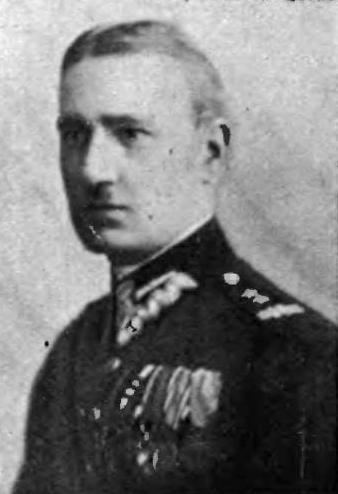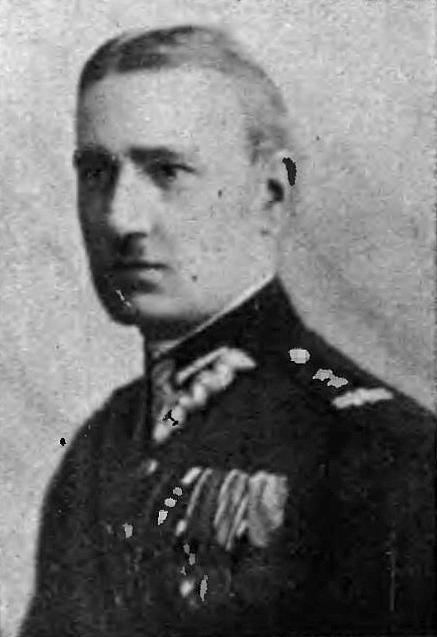Years of service 1914–1945 | ||
 | ||
Native name Edmund Heldut-Tarnasiewicz Battles/wars World War I,Polish–Soviet War,World War II (Invasion of Poland, Soviet invasion of Poland: Battle of Grodno (1939)) Name Edmund Heldut-Tarnasiewicz Died April 2, 1952, London, United Kingdom | ||
Edmund Wacław Heldut - Tarnasiewicz alias " Heldut " (born July 17, 1892 in Radom, Poland and died April 2, 1952 in London, United Kingdom). He was commander of the Polish Army cavalry, an officer of the Polish Armed Forces in the West, and received Poland’s highest military award, Knight of the Virtuti Militari,
Contents

Early life and career
Edmund Heldut was born on July 17, 1892 the son of John and Victoria from the family of Gajewski. He graduated from high school in 1909 in his home city of Radom and then from the School of Wawelberg and Rotwand in 1912 (the school was absorbed by the Warsaw University of Technology in 1951). In the latter year, he enrolled at the Ghent University, Belgium was active with the Riflemen's Association.
In July 1914 he began work in Kraków as an instructor. Upon the outbreak of World War I he joined the First Cadre Company. From August 20, 1914 he served in a military branch led by Władysław Belina-Prażmowski later becoming the First Cavalry Regiment of the Polish Legions. In this unit Tarnasiewicz stayed until the Oath Crisis in 1917. He was interned and imprisoned in a camp in Szczypiorno. In the service legion he attained the rank of Senior Uhlan. He used the pseudonym of "Heldut", and later took this name as his official name. In 1918 he enrolled at the Warsaw University of Technology.
At the end of the war in 1918, he joined the Polish Army. At the beginning of November 1918 he was sent to Chełm, where the squadrons were forming the First Cavalry Regiment. From November 24 he was the commander of the platoon. From January 8, 1919 this unit was renamed the 1st Regiment of Light Cavalry and from 20 April 1919 he became the squadron’s commander. He participated in the Polish-Bolshevik War, during which he was wounded near the river Daugava on September 5, 1919. He was appointed the Poruchik on May 1, 1920. For his deeds of war in the ranks of the 1st Regiment of the Light Cavalry he received the Order of Military Virtue or the Virtuti Militari.
From July 8, 1920 he served in the 16th Greater Poland Uhlan Regiment as a podporuchik of cavalry, and commanded by Major Ludwik Kmicic-Skrzyńskii whom appointed him commander of the 3rd Squadron. In this function he participated in battles against the Soviets (for service in the 15 ACS received the Cross of Valour). From 20 October 1920 he was commander of the squadron in 201st Light Cavalry Regiment. From 24 January to 1 September 1921 he was assigned to the Central School of Cavalry in Grudziądz. On 16 September 1921 he was the deputy commander of the 3rd Light Cavalry Regiment in Suwałki garrison. Later he was commandeering military education: he functioned as the commander of non-commissioned officers school, then as commander of the Reserve Officers School. After completing the course at the Training Centre in Rembertów from 4 June to 18 October 1925, again he served in the 3rd Regiment of Cavalry. He served as the Rittmeister. He was then promoted to major of the cavalry from 1 January 1927. From December 1927 to 1929 he held the position of commander of the Cavalry School of Non-Commissioned Officer Professional in Jaworow. He was appointed lieutenant colonel of the cavalry from 1 January 1930. From 1 July 1930, he served as deputy commander of the 4th Mounted Rifle Regiment of Łęczyca in Plock. Later, he returned to the 16th Wielkopolska Cavalry Regiment, stationed in Bydgoszcz, where from February 27, 1932 served as its commander. At that time, he was appointed colonel of cavalry from 1 January 1935. On 26 January 1935 at the palace in Bialowieza the Polish President Ignacy Moscicki gave him the rank of colonel with seniority 1 January 1935 and the 2nd in the body of cavalry officers. Together with him the rank of colonel was only received by two cavalry officers Witold Dzierżykraj-Morawski (lok. 1) and Leon Mitkiewicz-Żołłtek (lok. 3). Due to Colonel Heldut-Tarnasiewicz’s initiative all the families of the fallen in the battles for independence, they were awarded Polish lancers unit commemorative badges ID cards. In July 1939 he was commander of the Cadet School of Cavalry in Grudziadz at the local Cavalry Training Centre.
After the outbreak of World War II during the 1939 September Campaign he was the commander of the Suwalski Reserve Centre and the Podlasie Cavalry Brigade (his successor in this function was General . Brig. Waclaw Jan Przeździecki). He was an organizer and commander of the Reserve Cavalry Brigade “Wolkowysk”. After the Soviet aggression on Poland since September 17, 1939 he participated in the defense of Poland in the fight against the Red Army (including the 21 September in defense of Grodno), after which he was captured and interned in Lithuania. After his release and the official surrender of Poland he found himself in France and later in the United Kingdom. He was an officer in the Polish Armed Forces in the West. He held the position of commander of the Cadet School in the city of Edinburgh in Scotland and since 1942 deputy commander of the 10th Armoured Cavalry Brigade .
In 1944 he was investigated by the Regional Office of Internal Affairs in Lublin. After the war he remained in exile, residing in London, where he died on April 2, 1952. His remains were buried in Lublin.
In the 1920s he married Wanda Leokadia, the daughter of Polish landowner Julian Vincent - Skalski, who has acquired part of the Vincent wealth. They had a daughter named Danuta (1929-2011, after her husband Brodowska, operating in the National Armed Forces, later a teacher in Lublin) and a son named Andrew.
